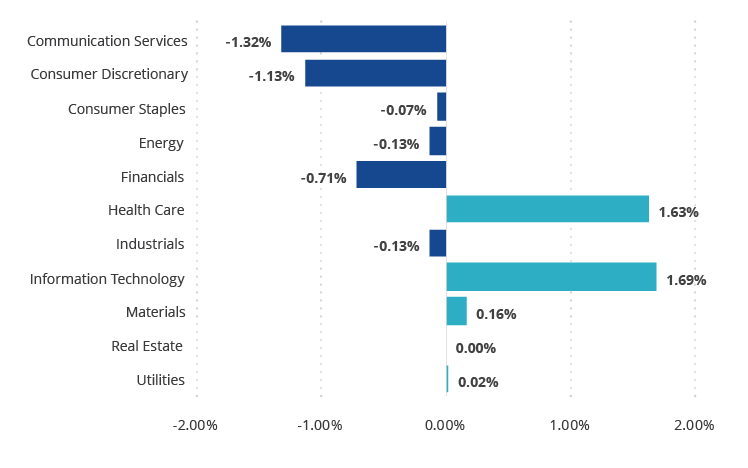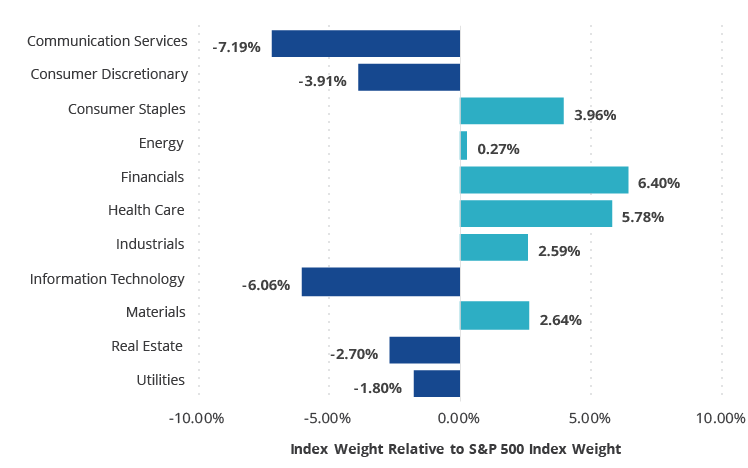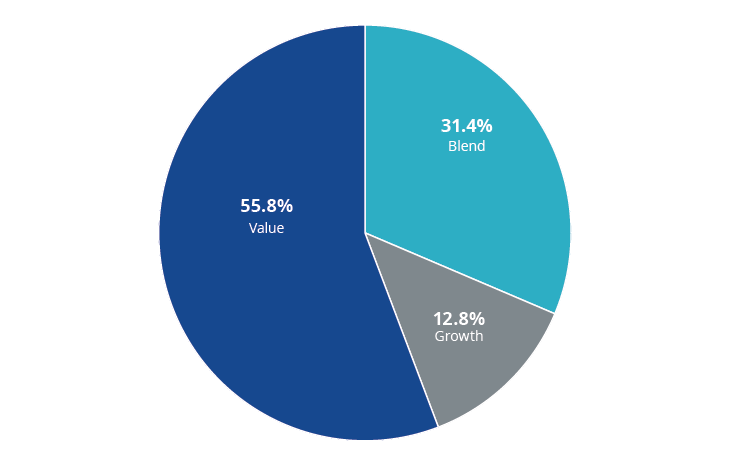Moat index review: Value is in, Facebook is out
Unfriended: Facebook removed
MOAT’s shift from big tech formally began in response to the June rebalance of MOAT’s Index, and took one step further last week as Facebook (FB) was removed; as a result of the September MOAT Index rebalance.
Facebook’s stock price premium to Morningstar’s assessment of its fair value signalled an opportunity to lock in gains relative to other opportunities in the wide moat universe. With the volatility big tech has faced in recent weeks, time will tell if Facebook rejoins the index in the future. For now, the only big tech names in MOAT are Amazon (AMZN) and Microsoft (MSFT), which together account for just over 2% weighting. This compares to a combined weighting of more than 22% in the S&P 500 Index for Facebook, Apple, Amazon, Netflix, Google and Microsoft. The steady increase in stock prices for many of these stocks recently is bringing them at or above fair value, according to Morningstar, and there simply remain too many other attractively valued opportunities in the US wide moat universe.
Modest sector shifts
Despite the removal of FB, the tech sector saw a slight increase in weight following the September review. Health care, a long-time overweight, also saw a slight increase in its exposure, while those gains resulted in similar reductions to communications services, consumer discretionary and financials.
Five Sectors account for minor repositioning of Morningstar® Wide Moat Focus NR AUD Index™
As of 21/9/2020

Source: Morningstar. Changes in sector weightings from 18/9/2020 to 21/9/2020 displayed above.
The decreases in consumer discretionary and communications services are logical to see as they are two of the top performing sectors in the US market in 2020. Tech is far and away the top performing sector in the market this year, yet interestingly, the tech exposure increased modestly. This is due mainly to an increase in semiconductor exposure, which has underperformed the broader tech sector this year. Applied Materials (AMAT) saw its position increased during the review and new entrant Lam Research Corp. (LRCX) was added following a recent economic moat rating upgrade from narrow to wide moat earlier this year. Cost advantages and intangible assets drive LRCX’s wide economic moat, according to Morningstar. Its research and development cost advantages over smaller peers and intangible assets related to equipment design from service contracts and customer collaboration leave LRCX well-positioned relative to competition in the chip manufacturing industry. It is an industry leader in the dry etch process and a prominent player in the deposition segment. Both of these processes combined are critical to chip fabricating.
Nike (NKE) and FB drove the consumer discretionary and communication services sector weighting lower as they both became too rich to remain in MOAT.
Financials and health care remain top overweights in Morningstar® Wide Moat Focus NR AUD Index™
As of 21/9/2020
Source: Morningstar.
Moat Style: Value over growth
MOAT's style exposure to growth companies remains low relative to historical averages. At times in the past when growth exposure has decreased, much of that decrease was offset by “core” or “blend” exposure, which are companies that exhibit characteristics of both value and growth. Now MOAT is skewed more heavily to value companies and historically has one of its highest exposures to value.
Value exposure in Morningstar® Wide Moat Focus NR AUD Index™ at all time highs
Morningstar Wide Moat Focus Index as of 21/9/2020

Source: Morningstar.
The last time MOAT had anywhere near this level of exposure to value companies was in mid-2018, shortly before the so-called “tech wreck” that coincided with the breakdown of U.S./China trade negotiations in the fourth quarter and subsequent market selloff led by tech stocks.
You can view full Index review results here.
Published: 23 September 2020
Important Disclosures
Issued by VanEck Investments Limited ACN 146 596 116 AFSL 416755 (‘VanEck’). This is general advice only, not personal financial advice. It does not take into account any person’s individual objectives, financial situation or needs. Read the PDS and speak with a financial adviser to determine if the fund is appropriate for your circumstances. The PDS is available here, and details the key risks. No member of the VanEck group of companies guarantees the repayment of capital, the payment of income, performance, or any particular rate of return from the fund.
An investment in MOAT carries risks associated with: financial markets generally, individual company management, industry sectors, ASX trading time differences, foreign currency, country or sector concentration, political, regulatory and tax risks, fund operations and tracking an index. See the PDS for details.
The Morningstar® Wide Moat Focus Index™ was created and is maintained by Morningstar, Inc. Morningstar, Inc. does not sponsor, endorse, issue, sell, or promote the Fund and bears no liability with respect to the Fund or any security. Morningstar®, Morningstar Wide Moat Focus Index™, and Economic Moat™ are trademarks of Morningstar, Inc. and have been licensed for use by VanEck.
Effective June 20, 2016, Morningstar implemented several changes to the Morningstar® Wide Moat Focus Index™ construction rules. Among other changes, the index increased its constituent count from 20 stocks to at least 40 stocks and modified its rebalance and reconstitution methodology. These changes may result in more diversified exposure, lower turnover and longer holding periods for index constituents than under the rules in effect prior to this date.




